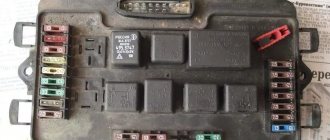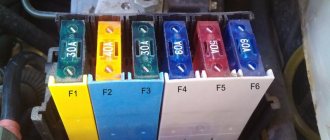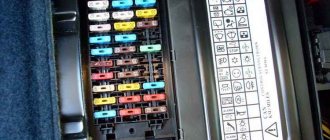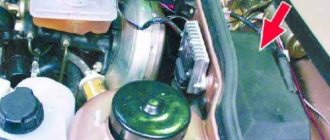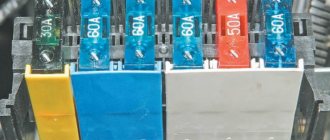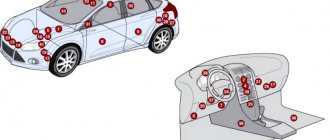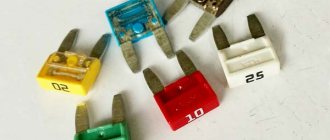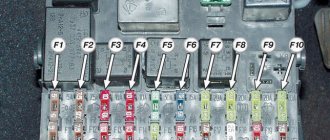Every car owner has encountered a situation where a fuse in a car has blown and part of the electrical equipment does not work. The complication of the machine design led to the introduction of additional electronic elements interconnected. Fuse links located in the engine compartment and passenger compartment de-energize circuits during short circuits, preventing fire or damage to expensive components.
Main reasons
Each fuse is responsible for the stable operation of certain electrical circuits. If the low-melting element melts, then some kind of malfunction has occurred. Sometimes such situations are isolated, that is, after replacing the fuse, the problem does not recur. But often it turns into a trend.
Experts identify several main reasons why protective fuses burn in a car. If you understand the reason and find the source of the trouble, you will be able to return the machine to normal operation.
- bad connection. It is possible that during installation or during operation on uneven roads, the quality of contact between the fuse and the block was impaired. Sometimes it’s all about the quality of the products themselves, which are not able to guarantee a tight connection. In this situation, the best solution would be to purchase higher quality security elements;
- wear. There is a fairly widespread opinion that the first time the load on the fuse is exceeded, it immediately fails. This is not entirely true. When the situation is critical and the load is really huge, the fuse element is immediately destroyed to break the circuit. But when the load is only slightly higher than normal, the fusible component gradually fails. The cross section decreases, and as a result, after several load sessions it finally burns out. Since fuses are consumables, they tend to fail without causing serious problems in the car itself;
- wrong choice at face value. Each fuse has its own rating. This is the current strength that he is able to pass through himself. If an element with an incorrect value is installed, it cannot withstand the load acting on it and quickly fails;
- sudden surges in voltage. If a sharp surge occurs in the electrical circuit for which the fuse is responsible, the element melts and fails;
- disturbances in the current path. Each fuse is designed for a specific load and is installed on the electrical circuit corresponding to its rating. If you shorten the length of the circuit, the resistance will decrease, and the fuse will pass a higher current through itself. On modern cars, electronics are not designed to withstand overloads. Therefore, special sensitive protective elements are installed in their electrical circuits. Under critical loads, they melt and break the circuit, thereby protecting the equipment from breakdowns.
avtoexperts.ru
It is foolish to underestimate the most important role in the car system of elements such as fuses. After all, they are able to protect the electrical component of the car from problems and various types of malfunctions. Most car enthusiasts have most likely encountered them more than once. But we must not lose sight of the fact that if they “burn” too often, this is fraught with more serious problems. Therefore, if you notice that you have to visit car dealerships quite often to purchase such parts, we strongly recommend that you look into this problem in more detail. Therefore, later in the article we will try to reveal the full answer to the question of why the fuse blew.
In the photo - Mazda Demio fuses
Reasons for failure
Remember that each fuse is responsible for a specific “circuit” and overlooking such problems in the first place is fraught with possible future problems in a global sense. A fuse has blown, which means there has been a breakdown in some network, perhaps some device is faulty, or there has simply been a power surge. You can determine exactly what each controller is responsible for using the “manual” for your model or asking on the forums dedicated to the model of your car. I would like to give a list of problems, or rather reasons, that could cause the fuses to fail:
Sometimes a situation arises that the fuse simply has an unreliable connection in the “block” (seat), which can lead to melting of parts or simply failure.
The fuse has blown
To protect yourself, it is better to purchase high-quality components from well-known brands.
• Trivial wear and tear. It is mistakenly believed that a fuse can fail instantly after a short-term slight increase in voltage in the network. This is not so, if the differences are only slightly higher than the norm, it will gradually begin to melt as a precaution, but not instantly. The so-called fusible part in this case gradually burns out until the cross-section finally decreases. Therefore, when buying a new set of fuses, at first it is better to monitor them and check their functionality.
• Initially, an unsuitable element was selected, for example, with a reduced current. If the selected current is less than in the network, it simply will not be able to transfer the load and in this case it will burn out instantly.
• It can also fail due to sudden surges in voltage, as already mentioned, for example, due to sudden blocking of electric motors.
Repair methods
As you understand, if you have to change fuses quite often, then the problem needs to be resolved. Most drivers do not worry about the failure of controllers, but simply carry a certain supply of parts in the car that can be replaced at any time. But, if you notice that they burn out quite often, you definitely need to look for the cause and then think about possible repair options.
Remember, if the fuse lights up immediately after installation, it means that the problem is hidden in which device and it must be “calculated”. There are not so many ways to do this. Let's give the most effective one. So, if some element has burned out, the first thing we do is study the documentation for the model. It is necessary to determine which circuit the blown fuse is connected to, and what devices and devices are connected there. For example, if a fuse has blown on a VAZ 2114, 2110, remember that there are twenty fuses, each of them has its own consumer group. For example, the most common fuses that fail are F1, F9 and F19.
Group F1 includes license plate lighting, instrument lighting, trunk lighting, and dimensions.
Group F9 includes windshield and headlight washers, as well as heated windshield and rear windows.
For group F19, the brake light relay, dimensions, turn indicators, generator winding, instrument display unit, clock, on-board computer, and central locking are included.
So:
Having determined the “package” of devices connected to the system, we turn on all the devices that interact with this controller.
• Get a screwdriver with a closed handle, preferably a special insulated one. Use the metal edge to gently touch the terminals of the fuse holder. If even a small spark jumps when touched, then the fault is still in the network. To “figure out” what exactly is “sick”, it is necessary to gradually remove the consumers, checking in the same way, touching the terminals. If, after removing the consumer, the spark disappears when touched, then the culprit has been found. We have identified a problematic element, we take it to the technician and determine whether it can be repaired; if not, we buy a new one.
Replacing the fuse
After replacing the source of the fault, you can safely buy a set of fuses that suit you. And here attention needs to be focused on which controller was there initially. If we threw it away and forgot, we turn again to the “manual” for the car.
In the photo - fuse diagram of the Opel Astra J
Remember that all fuses are marked with a specific color and number from the factory. Let’s say the number means “amperage”, that is, having taken out the blue one at 30 A, you need to install the same one. More or less “amperage” can subsequently lead to more serious repairs to the machine.
By the way, it is also important to find the right place to put the fuse. It happens in the dark or because of fright, drivers confuse the landing spots, which means the car may start to behave strangely. There have been cases where they confused the landing places, and then could not turn off the car with the air conditioner running or the headlights on. It could be anything. Therefore, if you are not confident in your abilities, it is better to turn to specialists.
What to do when a fuse blows
Novice motorists are naturally interested in what they need to do in situations when a car fuse blows.
Remember that the cost of these elements is significantly lower than the price of the equipment they protect. These are actually cheap consumables. You can purchase them as a whole set and always keep them on hand in case problems arise, the old device burns out and requires replacement.
Don't worry if the fuses blow. This is an absolutely normal situation for any car, regardless of the make, model, year of manufacture, etc. That is, this happens both on old cars and on brand new expensive foreign cars. No electrical circuit has 100% protection against current and voltage surges.
But you need to react completely differently when burnout becomes regular and constantly repeats even after replacing components. In such a situation, you should diagnose the car and check what is wrong in the electrical system. Moreover, it is strongly recommended to begin diagnosis as soon as possible after the first symptoms are detected.
If you installed a new fuse and it burned out almost immediately, then the car owner's task is to identify the source of the problem. To achieve the desired result, a number of activities should be carried out:
- Using the technical documentation for your vehicle, check which devices and equipment are connected to the problematic fuse. These instructions must indicate which fuse does what;
- now you need to turn on all systems and equipment for which the constantly burning protective element is responsible;
- take a screwdriver, the handle of which must be insulated. Use a metal part to touch the terminals on which the fuse is attached in or outside the block;
- if a spark occurs at the moment of contact, there is some kind of malfunction in the electrical circuit;
- disconnect one of the previously switched on consumers, and then repeat the manipulations with the screwdriver;
- when, after turning off the next device, the spark disappears, this will allow you to determine the culprit. This is what causes your fuse to blow.
Since you have managed to identify the source of the trouble, the appropriate repair or replacement of the unit is carried out. Further work directly depends on what exactly is wrong. If possible, you can fix the problem yourself. In case of serious malfunctions, which you have years of experience in eliminating, it is better to contact specialists.
When the cause of blown fuses has been eliminated, you can finally install a new protective element and continue operating your vehicle.
Design and principle of operation of the fuse
At the moment, there is a wide variety of shapes, ratings and sizes of such fuses, but their design and principle of operation are approximately the same. Only self-resetting fuses stand apart, but we will consider them in our article.
Operating principle of fuses
Let's start our conversation with the principle of operation of fuses. This will make it easier to understand the design and testing methods of these switching devices. Well, of course, their repair.
Joule-Lenz law
- If you remember your school physics course, you should know that when current flows through any conductor, the latter heats up. How much it heats up depends on the material of the conductor, the current strength and the cross-section of the conductor. There are many more small factors, but at this stage we will discard them.
- So, if a current of 13A is passed through a wire with a cross-section of 1 mm2, the conductor will heat up, but only slightly. If the same current is passed through a wire with a cross-section of 0.5 mm2, the conductor will heat up approximately twice as much. And if you compare copper and aluminum conductors, the latter will heat up even more - as in the video.
When heated, the conductor gives off some of the heat to the environment
- As we again remember from the school physics course, the more a conductor heats up, the worse it conducts electric current. That is, its resistance increases - and since the resistance increases, but the current remains the same, it will heat up even faster.
- It turns out that if you take two identical conductors, one with a temperature of +20⁰C, and the second with a temperature of +60⁰C, and pass the same current through them, then the second conductor will release a large amount of heat in the same period of time. These properties are the basis for the operation of fuses.
Dependence of insert heating on its material
- Essentially, a fuse is a piece of conductor with a strictly calculated cross-section. When a current flows through it below the maximum permissible, it heats up, but does not reach the temperatures at which melting of this material occurs. After all, the greater the temperature difference between the conductor and the surrounding atmosphere, the faster it cools.
Fuse operation
- If the current exceeds a certain value, then this conductor is heated to a temperature at which it melts. As a result, it collapses, thereby breaking the chain. And since there is no circuit, then there is no current. That's it, the fuse fulfilled its function, protecting our circuit from too high currents. Bring a new defender.
Fuse design
To answer the question: “Fuse - how to check?”, you need to know its design. These switching devices come in several types - tubular, blade and self-healing.
Tubular fuses are the most widespread. Knife ones are used much less frequently and mainly in the automotive industry. Self-healing ones are usually used in low-voltage electrical engineering.
Fuse design
- A tubular fuse consists of a body – usually a tube, which is why it got its name. It is usually made of dielectric materials - glass, ceramics or other dielectrics.
Note! You may find rectangular shaped tubular fuses. This does not change the essence of the issue; they are still classified as tubular.
Tubular fuse
- The beginning and end of such fuses usually have a contact part. It may simply be a seal made of conductive material. Or maybe an ending with a contact part.
PPN series fuses
- The ending can be collapsible, or it can be non-removable. It depends on the design. But usually fuses for low rated currents are made non-removable. It is believed that the cost of completely replacing such a fuse is lower than the labor costs to repair it.
- For fuses with a higher rated current - from 20A, the termination is usually made removable for possible replacement of the fuse link. Typically these are threaded connections.
- There is a fuse-link inside the housing. This can be an ordinary piece of wire of a certain cross-section. Or maybe a special insert. A piece of wire is usually found in fuses with a small current rating. Usually it is soldered to the end, or attached using crimping.
Fuse design with removable fuse link
- Special inserts are attached to the fuse end, sometimes using special clamps, but most often using conventional bolted connections.
- The internal cavity of the body may be hollow, or may contain a special filler. The purpose of such a filler is to extinguish the arc that may occur when the fuse link burns out. Quartz sand is usually used as a filler.
Blade fuse
- As for blade fuses, they usually have a plastic body and two blade contacts. This is where the name came from. A fuse-link is attached to these contacts by soldering.
Checking burnt elements
Motorists should understand how to check the fuses in their car. An overload in the electrical network does not always lead to failure of the fuses themselves. They are the easiest to check, so diagnostics usually start from here.
When an electrical appliance stops functioning, it is far from certain that the protective element is to blame. Here the most correct and rational solution would be to check the status of the device responsible for the faulty device in the car.
A fuse map will be a very useful tool in the diagnostic process. On all modern cars it is located directly on the cover of the safety block.
There are several main verification methods:
The simplest method is considered to be by replacement. You just need to install a new fuse in place of the potentially faulty device. But it is fair to consider this technique identical to visual inspection. After all, it is easier to determine by external aspects than to change each of the fuses located in the block in a row.
Visual inspection
Let's start with how to understand whether a fuse has blown in a car, based purely on the appearance of the element. This method is considered the most correct, since it is quite easy for many people to visually verify that a breakage of a low-melting component has occurred.
To check, you will need to remove the element, bring it to the light and look at it carefully. It will not be difficult for an experienced motorist to find out and understand whether the fuse in his car has blown or not. Beginners do not understand this right away, which raises several more questions regarding how to get an accurate answer.
A worn fuse is not difficult to identify. This manifests itself in the form of broken wire (low-melting alloy) or burnt marks. Symptoms such as these indicate that the electrical circuit has broken and the fuse needs to be replaced.
A similar testing method is relevant for those fuses that are made from glass or transparent plastic. Most of them are found in passenger cars.
But the method also has a significant drawback. The test is performed by a person, without the use of any instruments. In some cases, especially for beginners, a visual examination does not provide a 100% guarantee of a correct diagnosis. Therefore, it is much more correct and efficient to check fuses using multimeters.
Choose the right fuse
Since the fuse performs a very important function - it insures the car’s expensive electronics against failure, such a “protector” should be chosen extremely carefully. Taking advantage of the fact that when buying one or two “penny” protective devices, the majority of car owners do not pay attention to their quality, unscrupulous sellers or manufacturers try to sell goods that do not meet any quality standards.
Of course, it is very difficult to distinguish a quality product from “garbage” by appearance. You can use the following method to check. You need to connect one of the purchased fuses to the battery. A quality product will be indicated by its rapid burnout. If it starts to heat up and melt, using it in a car is extremely risky - if it is overloaded, the electrical circuit will not open, which can result in either failure of the electronics or a fire.
The other extreme, which car owners often resort to - the use of bugs, can lead to equally sad consequences. The designs of such devices can be very diverse - from wire wound around the ends of a burnt-out device, to a coin inserted as its replacement. Such “homemade products” pass current of any magnitude, since they cannot burn out, which leads to dire consequences, especially for foreign-made cars.
Recommendations for replacement
If you carefully study the instructions, there is nothing particularly complicated in the procedure for replacing the protective element. But it’s worth following certain rules and recommendations.
- Before removing a burnt-out device, make sure you have a new element available. It is the selection and purchase of new fuses that is considered the most difficult stage in the entire replacement work.
- By checking the functionality of all equipment, you will be able to identify the culprit of the incident with your car. Make sure that the problem is in the fuse, and replacing it will restore the car's functionality.
- Now let's move on to how to remove and properly pull out a blown fuse in a car. Anyone who has pulled out elements before is unlikely to encounter any difficulties. You can pull out the device using a special device in the form of pliers. Remove the device carefully, without jerking or tugging on the sides. Otherwise, you risk breaking the case, and the contacts themselves will remain in the socket. Getting them separately will be much more difficult. Previously, large fuses were used that were easily removed with your fingers. But the increase in their number in the car led to a decrease in the structures themselves. Therefore, it is better not to pick around with your hands and fingers, but to take pliers and use them to remove the problematic fuse.
- Check the element for functionality. Since visual inspection does not always give an accurate answer to the question of the condition of the fuse, the best solution is to use a multimeter. Modern fuses are made of transparent plastic or glass. The state of the low-melting thread is usually clearly visible through the body.
- Once the driver has taken the fuse with pliers and pulled it out, it is worth inspecting it. It is possible that there are other problems with the car, and this element has nothing to do with it. We remove it carefully in any case, even if the device is definitely out of order.
- Install the new fuse in its rightful place. Here it is important to adhere to the rule that a fuse with the same rating is inserted into the same socket. You already know about the consequences of choosing the wrong protective elements, so you definitely don’t want to risk the integrity of your vehicle.
- It is considered a big mistake not only to use fuses of a lower rating than required, but also to use a larger one. Some motorists believe that it is possible to replace a 30-amp device with a 40-amp element, which will supposedly be more stable, durable and reliable. But this is a mistaken opinion, which can result in expensive repairs. If the car manufacturer has provided that this socket goes into a device rated 10 Amps, and this socket is rated 40 Amps, install new fuses that way.
- For reinstallation, use the same pliers that were used to remove the burnt-out protective element in the safety block.
Upon completion of the work, you need to check all systems that have stopped functioning due to a blown fuse. If everything works, feel free to close the unit and continue to safely operate your car.
It will sound a little strange, but quite often situations arise when motorists install fuses in the wrong sockets where they should be placed. This can be explained by poor lighting, vision or memory.
There is nothing surprising here, since the nests in the block are very dense and close to each other. Because of this, you don’t always remember exactly where this or that element was extracted from. If in doubt, refer to the instructions or check the map on the safety block cover. This will save you from unwanted mistakes.
If it blows out in the wilderness: how to safely restore a car fuse?
The fuse is one of the oldest electrical devices. The inventor of the fuse is believed to be Louis Francois Clément Breguet, a French electrical engineer. In 1847, he conducted a series of experiments and found out that inserts made of thin wire of a fixed cross-section are capable of burning out when the current in the electrical circuit exceeds a certain strength proportional to the cross-section. The practical use of fuses as devices began approximately in the middle of the 19th century - first in industrial and household electrical engineering, and with the widespread use of “steel horses” - in automotive applications. Despite the invention of various types of automatically reset fuses - spring, bimetallic, semiconductor - the most common disposable fuse by Louis Breguet is still the most common and effective device for protecting electrical circuits in any car from current overload and short circuit.
In both budget and premium cars, almost all electrical consumers are protected by fuses. And in the manual for any car, and even more so in the maintenance and repair manual, there is always the following (or very similar) phrase:
It is prohibited, even temporarily, to install jumper wires in place of the corresponding fuses, as this may damage the electrical wiring and cause a fire!
It is said correctly, and we do not intend to argue with it. However, we note that there are all sorts of circumstances, including not quite ordinary ones. And any owner of a car that is middle-aged and has seen life may find itself in a situation where some important fuse for driving has burned out - in the circuit of the fuel pump, ignition, windshield wipers in the rain, headlights at night, etc., and there is nothing to replace it with. This can happen not only in the city, where there are a lot of car shops, sympathetic citizens, as well as car services and tow trucks, and finally, but in the wilderness, when there are no spare fuses in the stash, there are no shops or just kind people nearby, but you still need to go...
So it is better to have knowledge “for a case that will not happen” than to be helpless in an unlikely, but still extreme situation! What is the supposed Japanese proverb that people love to write in statuses on social networks? “A samurai carries a sword all his life, even if he needs it only once in his life”... Or something like that...
When the bug... was the norm
Young car owners are well acquainted with modern U-shaped blade fuses, and, as a rule, are familiar with their predecessors, common on Soviet cars - rod-type fuses with their always lousy contacts. But what happened EVEN EARLIER, most likely, they no longer remember...
But until the 70s, cars (by the way, not only Soviet ones!) used fuses that were very similar to modern U-shaped blade fuses. They were a textolite plate with riveted springy contact legs and 15-20 centimeters of spare wire wound around it. If the wire between the contacts burned out (the fuse tripped), the driver simply unwound a few centimeters from the reel and reconnected the contacts. The fuse has restored its properties!
Not to say that this principle was ideal - the contact in the wire fuse often deteriorated over time, since it depended on the strength and accuracy of winding the wire. However, the system still existed for many years on a wide variety of cars and trucks and was considered quite functional. And pay attention: by modern standards, this is a natural “bug”!
"Bug" - but not a "bug"! Such a fuse would be considered a “bug”, dangerous and prohibited for use, if RANDOM wire was used in it! But the wire in it was strictly calibrated, with a cross-section corresponding to the required protection current, the value of which was printed on the fuse body! Therefore, if you take a modern knife-type fuse (burnt out) and connect its legs with a wire, whose combustion cross-section approximately corresponds to the current marked on the fuse initially, then such a “bug” will not pose a danger to the car’s electrical wiring. But how do you know what kind of wire is needed?
Wire diameter and combustion current
But for this there is a special calculation formula. But more often, for simplicity, a lookup table filled in with this formula is used! At one time, when technical creativity was considered entertainment, and not degradation on social networks, every schoolchild who attended a radio club knew this sign. Because making a fuse for a homemade design with your own hands was the norm! In the reference plate, for convenience, the cross-section of a single-core copper wire has already been converted to diameter.
For the most common car fuse ratings, the table looks like this. If you are interested in other current values (and these tables usually include wire diameters for making fuses from 0.5 amperes to 200-300 amperes), then it will not be difficult to google the full version.
For example. In the common “twisted pair” LAN cable used to provide Internet access to apartments, one core has a diameter of about 0.5 mm - a piece of such wire will act as a fuse at a current of about 30 amperes. In stranded wires of the ShVVP type, used to connect electrical appliances to an outlet, cores with a diameter of 0.2 mm are often used - for 7 amperes... If you fold it in half, you get a fuse of 14-15 amperes. Well, etc.
Measuring wire without calipers and micrometer
OK, now we know how to make a relatively safe “bug” for the current we need... And in principle, finding a wire and unbraiding it into strands is not difficult - in extreme cases, you can cut and clean the insulation from the wire of a carrying lamp, a USB cord, or it is also possible to temporarily “ampute” some standard electrical circuits in the car by cutting off the wire from something not very necessary, such as a rear fog light... In the end, extreme situations sometimes require extreme solutions.
But how can we understand what current a wire is designed for if we don’t know its diameter? After all, it is impossible to determine the thickness by eye! But, as a rule, there is neither a caliper nor a micrometer in the trunk... And again, old-fashioned tricks will come to the rescue - simple but reliable.
We take any cylindrical object - a pencil, a screwdriver, a match, a twig - and wrap the wire around it tightly, turn to turn. The more turns, the higher the measurement accuracy will be, but usually 15-20 turns are enough. Wound - measure the total length of the winding with a ruler and divide the resulting number of millimeters by the number of turns. The result is the wire diameter!
The bores will mutter: “Well, yes, I don’t have spare fuses with me, but I found a ruler in the car, you see!” Especially for bores: well, the 21st century is just around the corner... Many, for example, have a ruler in their smartphone!
Making a bug fuse
...well, the last step - if the wire is found, its diameter is measured, and it suits us. We wrap a piece of copper wire tightly and tightly around the legs of the burnt fuse and insert it into place. Ready!
And finally, we remind you once again that it is necessary to carry out such repairs, even far from civilization and help, very, very carefully! Make a “bug” only after finally making sure that the factory fuse similar to the burnt one cannot be, at least temporarily, pulled out of the circuit where it protects something that you can temporarily do without, for example, a heated rear window or something similar. And if there are no spare ones, there is nowhere to pull it out from and there is no one to turn to for help - then just wind the “bug”... But do not forget to replace it with a normal fuse at the first opportunity and find out the cause of the burnout!
Survey
Have you ever been stuck in the middle of nowhere with a faulty car?
Your voice
Total votes:
Automotive fuses and their classification
On a car, most fuses are located in blocks. Most often there are two or more fuse boxes on a car. One of them is located under the hood or in the luggage compartment area. It is called the main one and includes the largest number of fuses. The other unit is located under the front panel in the passenger compartment, but in different places for all cars. Also, fuses can be located separately throughout the machine - 1, 2 or 3 pieces.
Automotive fuses are classified according to two parameters - size and rated operating current.
When choosing a car fuse, you should pay attention to the size:
In addition to the size, when purchasing a fuse, you should know its current rating. Most often, elements are installed in cars that have a rated current of 5 to 30 A. The easiest way to determine the fuse current is by its color, and below is a table that shows how the color and rated current of the fuse are related.
Replacing fuses yourself
Replacing a burnt-out device with your own hands is a matter of just a few minutes. Naturally, in order to avoid subsequent replacement of the entire fuse box, this simple manipulation should be taken with full responsibility. After accurately identifying the source of the problem, replacing the fusible protector should begin with selecting a new one that exactly matches the damaged one. For ease of “identification”, all devices have a different color - in accordance with their power.
It is best to purchase fuses in advance, without waiting until one of them fails. At the same time, you should be based not on your own preferences and cost, but on the recommendations of the manufacturer. If they are not available for sale, it makes sense to place an order and wait a little rather than put your car and yourself at risk. As a last resort, temporary use of fuses of suitable size and characteristics is allowed. A detailed algorithm of actions for correctly replacing a faulty fuse can be seen in the video:
How to check a fuse in a car
If a circuit in a vehicle is overloaded, one or more fuses will interrupt the circuit and fail. However, if an electrical device stops working, it is far from certain that the problem is in the fuse. In this case, the right solution would be to diagnose the element in the fuse box that is responsible for a specific electrical device.
It is easy to determine which fuse has failed using the car's instructions. It contains a “map” that shows where the elements responsible for a particular electrical device are installed in the fuse box. This map determines the location of the fuse, due to which the circuit of the electrical device could be de-energized, and then it is necessary to diagnose it. In modern cars, the card is located directly on the fuse box cover.
Visual inspection of the fuse
It is believed that the surest way to check a fuse is to visually inspect it for a break. To do this, the fuse is pulled out of the block and then examined in the light. If the wire inside is broken or there are burnt marks on it, then the circuit is broken due to the fuse.
This method is applicable for glass or transparent plastic fuses, which are the majority. However, the method has a significant disadvantage - it is based solely on human verification and does not have confirmation by a device. Visual inspection sometimes turns out to be erroneous, and it is better to use a tester to determine the integrity of the fuse.
How to check a fuse with a multimeter
To test a circuit element, a common device is used - a multimeter, also known as a tester. The device is indispensable for the car enthusiast, and it allows you to check the car fuse in two ways.
Voltage test
To diagnose a faulty fuse in a car circuit, you must:
Take a multimeter and set it to voltage measurement mode;
- Next, turn on the car circuit with which problems are observed - light, heater, mirror heater or another;
- After this, check the voltage at one terminal of the fuse responsible for this circuit, and then at the other terminal;
- If there is no voltage at one of the terminals, the fuse has blown and will need to be replaced.
This method is good for its simplicity, and in just a few seconds it allows you to determine if there is a problem with a fuse or other element connected to the circuit. However, it also has a disadvantage; using this method it will be difficult to measure the fuse voltage in some circuits, for example, a door lock or an audio signal. It is easier to do this using the second method described below.
Resistance test
A faulty fuse can be diagnosed by its resistance. To do this, you need to remove the element from the machine and switch the multimeter to the mode for measuring electrical resistance (Ohms). After this, the tester leads are connected to the fuse terminals, and if zero electrical resistance is displayed on the screen, it means the element is faulty and needs to be replaced.
It is believed that a failed fuse can be replaced with a wire that can restore the electrical circuit. This is true, but this method of “repair” is extremely undesirable. By installing a wire in place of the fuse, the motorist does not solve the problem, but only complicates it. In emergency cases, this is acceptable, but if you “ride on a wire” for a long time, the car’s electrical wiring will begin to melt, which can result in expensive repairs.
